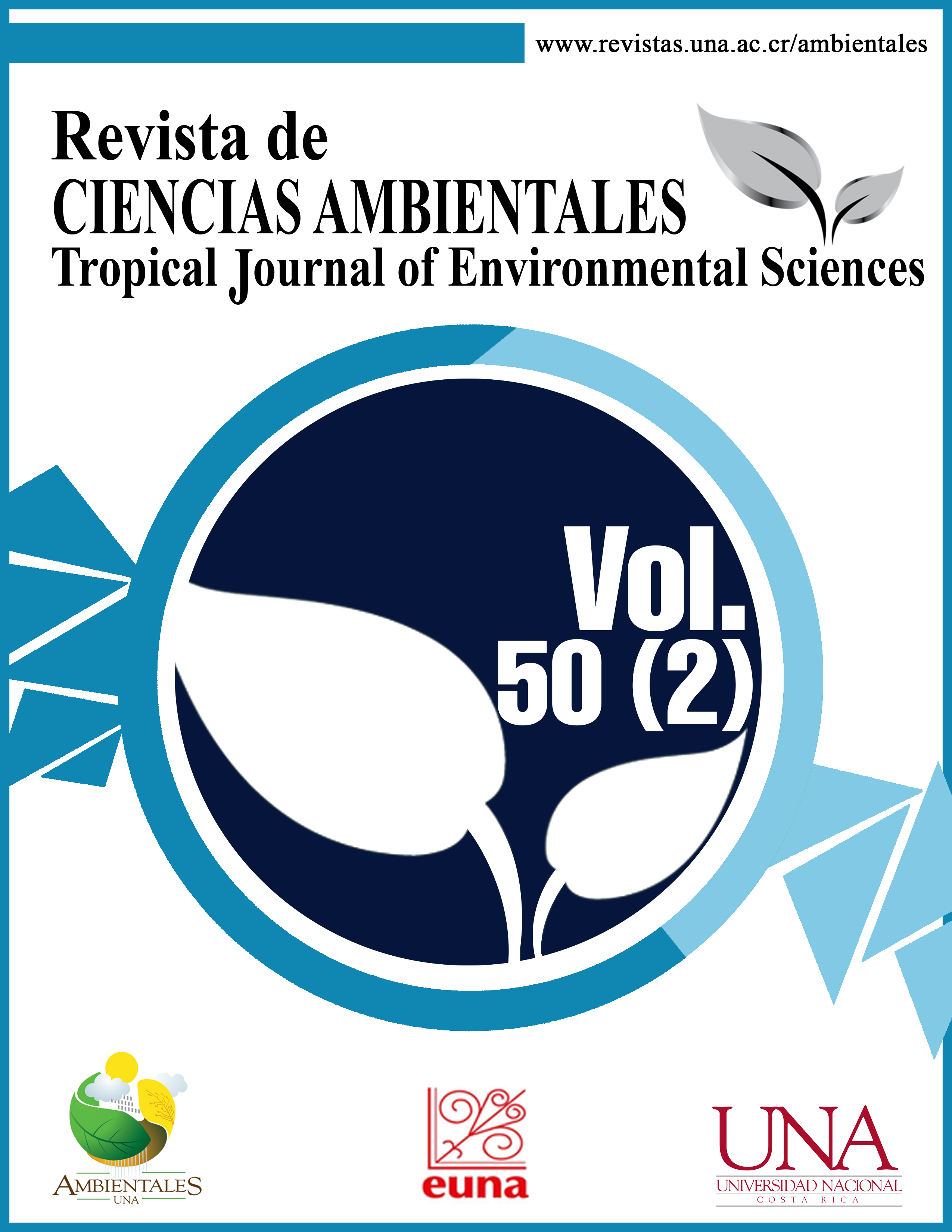Evaluation of Macro and Micronutrients Concentration in the Melina (Gmelina arborea) Aerial Biomass (AB) of One to 12 Years Old in Southern Costa Rica
DOI:
https://doi.org/10.15359/rca.50-2.1Keywords:
Forest plantation, Lamiaceae, nutrients, soil.Abstract
Concentration of macro and micronutrients in one to 12 years old melina aboveground biomass (AB) components (stem, bark, leaves, primary and secondary branches) in the south zone of Costa Rica and confidence intervals of concentrations for N, P, K, Ca, Mg, S, Fe, Mn, Zn, Cu, and B were determined. Sampling consisted of two trees by age, with the exception of one age. Then, a total of 23 trees were cut and distributed in ages from one to 12 years. Some soil variables (pH, soil acidity, SA, and CICE) were correlated with the concentration of macro and micronutrients in the melina aerial components. The order of biomass components in accordance with total concentration of macronutrients was leaves (6.3%), bark (3.57%), secondary branches (2.56%), primary branches (1.72%), and the stem with the lowest total concentration (0.78%). The largest single concentration of macroelements in all components was the N, Ca, and K, and the least abundant was the Mg, P, and S. The order of the components in the total concentration of micronutrients was bark (765 mg kg-1), primary branches (323 mg kg-1), secondary branches (314 mg kg-1), leaves (295 mg kg-1), and the stem (190 mg kg-1). The concentration of Ca increases in the bark, primary, and secondary branches, while K decreases (in all components) with increasing age of the plantation. In all AB components there is a high positive correlation with average concentration of Fe and Mn with removable soil acidity.
References
Agus, C., Karyanto, O., Hardiwinoto, S., Haibara, K. y Toda, H. (2000a). Biomass in fast growing species of tropical Gmelina arborea Roxb. plantation forest. In Transaction of the 111st Japanese Forestry Society (pp.557-558).
Agus, C., Sumardi, O., Hardiwinoto, S., Na'iem, M., Sipayung, M., Wardana, W., Haibara, K. y Toda, H. (2000b). Biomass of carbon and nutrient stock in Gmelina arborea Roxb. plantation forest. Proceeding Seminar on Forest Biomass. GMU-JIFPRO. Yogyakarta.
Agus, C., Karyanto, O., Kita, S., Haibara, K., Toda, H., Hardiwinoto, S., Supriyo, H., Naiem, M., Wardana, W., Sipayung, M.S., Wijoyo, K. y Wijoyo, S. (2004). Sustainable site productivity and nutrient management in a short rotation plantation of Gmelina arborea in East Kalimantan, Indonesia. New Forest, (28), 277–285. doi: http://dx.doi.org/10.1023/B:NEFO.0000040954.27630.2f
Arce, H. (2012). Plantaciones forestales establecidas mediante pago de servicios ambientales (PSA). En presentación sobre “Informe Interno Anual FONAFIFO 2012”. Sp.
Arias, D., Calvo, A., Richter, D. de B. y Dohrenbusch, A. (2011). Productivity, aboveground biomass, nutrient uptake and carbon content in fast-growing tree plantations of native and introduced species in the Southern Region of Costa Rica. Biomass and bioenergy, 35, 1779-1788. doi: http://dx.doi.org/10.1016/j.biombioe.2011.01.009
Avellán, M. J. (2012). Determinación y variación de la concentración foliar de nutrimentos de Gmelina arborea Roxb. en Osa, Corredores y Golfito, Costa Rica (Tesis de Licenciatura). Universidad Nacional de Costa Rica,
Caguasango, S. M. (2012). Modelación de la calidad de índice de sitio – suelo sitio específico mediante criterios de disponibilidad de nutrientes en plantaciones de Gmelina arborea y Pachira quinata en bosque seco tropical (Zambrano – Bolívar) (Tesis). Universidad Distrital Francisco José de Caldas Bogotá, Colombia.
Correndo, A. y García, F. (Marzo, 2012). Concentración de nutrimentos en planta como herramienta de diagnóstico: Cultivos extensivos. Archivo Agronómico #14, IPNI International Plant Nutrition Institute.
Drechsel, P. y Zech, W. (1991). Foliar nutrient levels of broad-leaved tropical trees: A tabular review. Plant and Soil, 131(1), 29-46.
Escobar, L. J. (2013). Relación de parámetros de fertilidad del suelo con el índice de sitio determinado para plantaciones forestales de melina (Gmelina arbórea) y ceiba (Pachira quinata) en Zambrano-Bolivar (Colombia) (Tesis de maestría). Universidad Nacional de Colombia.
Evans, J. (1979). The effects of leaf position and leaf age in foliar analysis of Gmelina arborea. Plant and Soil, 52(4), 547-552. doi: http://dx.doi.org/10.1007/BF02277950
Henríquez C., Bertsch, F., Salas R. (1995). Fertilidad de suelo: Manual de laboratorio. San José, Costa Rica: Asociación Costarricense de la Ciencia del Suelo.
Holdridge, L. (1982). Ecología basada en zona de vida (Trad. del inglés por Jiménez, H. Segunda reimpresión). Instituto Interamericano de Cooperación para la Agricultura. San José, Costa Rica.
Instituto Meteorológico Nacional (IMN). (2008). Clima, variabilidad, cambio climático en Costa Rica. Recuperado de http://www.slideshare.net/Socialesdigital/el-clima-variabilidad-y-cambio-climatico-en-cr
Kok, R. (2012). A revision of the genus Gmelina (Lamiaceae). Kew Bulletin, (67), 293-329.
Murillo, R. (1996). Evaluación de algunos factores ambientales que afectan la calidad de sitio a nivel de micrositio para melina (Gmelina arborea Robx) plantada en suelos planos en la zona Sur de Costa Rica (Tesis de licenciatura). Universidad Nacional. Costa Rica.
Murillo, R. y Alvarado, A. (2012). Nutrición y fertilización de Gmelina arborea. En A. Alvarado y J. Raigosa (Eds.), Nutrición y fertilización forestal en regiones tropicales (pp. 285-299, 1era ed.). San José, Costa Rica: Asociación Costarricense de la Ciencia del Suelo.
Negi, J. D. S., Bahuguna, V. K. y Sharma, D. C. (1990). Biomass production and distribution of nutrients in 20 years old teak (Tectona grandis) and Gamar (Gmelina arborea) plantation in Tripura. Indian Forester, 116(9), 681-686.
Ogbonnaya, C. y Kinako, P. (1993). Growth and mineral nutrition of Gmelina arborea Roxb. Tree Physiology, 12, 291-299.
Olaleye, A. O., Aderinola, A. P., Onasanya, A. S. y Akinbola, G. E. (2002). Utilization of Gmelina aborea (Roxb) to ameliorate a degraded Alfisol in South-Western Nigeria.
Onweremadu, E. U. (2007). Pedogenic loss and uptake of calcium by Gmelina growing in na Isohyperthermic Kandiudult. Journal of Plant Sciences, 2(6), 625-629. doi: http://dx.doi.org/10.3923/jps.2007.625.629
Onyekwelu, J., Mosandl, R. y Stimm, B. (2006). Productivity, site evaluation and state of nutrition of Gmelina arborea plantations in Oluwa and Omo forest reserves, Nigeria. Forest Ecology and Management, 229, 214–227. doi: http://dx.doi.org/10.1016/j.foreco.2006.04.002
Osundina, M. A. y Osonubi, O. (1989). Adventitious roots, leaf abscission and nutrient status of flooded Gmelina and Tectona seedlings. Tree Physiology, 5, 473-483. doi: http://dx.doi.org/10.1093/treephys/5.4.473
Sampaio, LM. y Huber, W.E. (1999). Concentração e distribuição de nutrimentos nas folhas de espécies florestais, na Amazônia Ocidental. Floresta e Ambiente, 6(1), 127-137.
Stuhrmann, M., Bergmann, C. y Zech, W. (1994). Mineral nutrition, soil factors and growth rates of Gmelina arborea plantations in the humid lowlands of northern Costa Rica. Forest Ecology and Management, 70, 135-145. doi: http://dx.doi.org/10.1016/0378-1127(94)90081-7
Downloads
Published
How to Cite
Issue
Section
License

This work is licensed under a Creative Commons Attribution-NonCommercial-ShareAlike 4.0 International License.



















